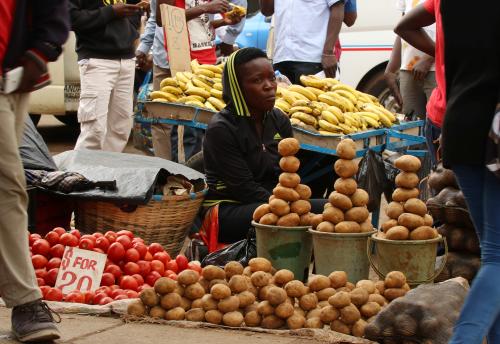The United Kingdom is widely seen as a global leader in the fight against hunger, through its powerful combination of nongovernmental campaigns, scientific research, global alliances, generous aid, and staunch political commitment. The 2016 Brexit vote and the consequent departure of former-Prime Minister David Cameron who had made foreign aid a trademark cause offer an opportunity to take stock.
The political profile of the U.K.’s support to food and nutrition security (FNS) was greatly raised after the global food price crisis of 2008 and parallel advances in nutritional science. This complemented—and some believe, quickly eclipsed—longstanding emphases on broader food sufficiency and improved rural livelihoods. It led, among other initiatives, to a headline U.K. government pledge of 4.5 billion pounds ($5.6 billion) of additional nutrition-related aid between 2013 and 2020.
Nonetheless, my closer examination of the U.K.’s FNS aid profile presented a surprisingly mixed picture. Particularly striking is the U.K.’s low share of direct FNS spending in its total aid (4 percent). The deficit is smaller, but still significant, when aid through multilateral channels such as the World Bank is factored. By exploring how to rectify this apparent contradiction, I found four key issues:
To what extent is FNS a real priority for U.K. aid?
Behind the U.K.’s unconvincing raw FNS aid effort result, there is qualitative support for the idea that agriculture and improved farm incomes and productivity remain central to U.K. international development strategies, particularly via structural transformation for growth and climate change adaptation. Agriculture and rural development drive the relatively low FNS effort, as nutrition-specific aid has recently grown faster. It takes time for new programs in, say, agricultural value chain development to build momentum. Perhaps some of the newly expanding areas are also supply-constrained through temporary skills bottlenecks. And spending on rural social-protection and livelihoods projects may also have become, temporarily at least, politically less attractive.
Does the U.K. pursue an integrated approach to FNS?
Not really, given the current, largely nutrition-led accountability framework, which also includes the major financial commitments for which the U.K. remains accountable. This headline emphasis on nutrition does not preclude a more balanced FNS approach, in which it is widely understood both that (a) food insecurity is a root cause of poor diets, as well as (b) that achieving food security will not by itself improve dietary quality for vulnerable groups. The U.K. Department for International Development already has a methodology in place for measuring and encouraging both nutrition-specific interventions and nutrition-sensitive interventions, the latter mostly in agriculture, health, and social protection. This methodology needs to be mainstreamed and improved.
How to strike the balance between small farmers, growth, and poverty reduction?
The U.K.’s conceptual approach to smallholders recognizes their diversity and vulnerabilities, as well as their growth potential and wider economic transformation spillovers. It also enables aid agency staff to argue more forcefully for agriculture investments within the context of a larger economic development strategy, which helps balance parallel U.K. agendas on protracted humanitarian crises and climate change resilience. In the short term, however, the U.K.’s FNS aid priority pendulum has probably swung too sharply away from supporting vulnerable and nonviable small-holders (“hanging in”) and toward “stepping up” or “stepping out” investments for the smaller groups who can, respectively, intensify farm production or move to viable off-farm employment.
What are the post-Brexit opportunities and risks for agricultural trade and producer subsidy reform?
There are compelling arguments for reform of U.K. policies that were formerly restricted by the EU regimes, include pressure from consumer interests for lower prices; the potential for fiscal savings; environmental benefits; greater equity between large and small U.K. farmers; and the removal of conflicting interests between EU countries that are more exposed to developing country agriculture and the U.K.
The archetypes for future subsidy regimes include (1) complete subsidy removal (2) a shift to insurance-based policies, as in the United States and (3) a wider system of rewards to farmers for generating specific environmental and other benefits. Various combinations and transitional scenarios have been mooted. In the meantime, it should be a source of political concern that public policy statements on Brexit do not mention the potential vulnerabilities of low-income countries.
Key Recommendations:
- DFID should monitor FNS aid spending as a “canary in the coalmine” check on the levels and composition of U.K. aid in a structured fashion, such as by using the Ending Rural Hunger Project
- The G-7 could endorse an improved FNS aid accountability framework, like the Ending Rural Hunger Project
- The OECD Development Assistance Committee could align its reporting on FNS more closely with the Scaling Up Nutrition accountability framework used by the U.K. and others.
- In the aftermath of humanitarian responses to the current famine in the horn of Africa, the U.K. should revisit the shape and extent of its rural social protection programs.
- There should be explicit consideration of the impacts of alternative agricultural subsidy and trade policies post-Brexit on low-income countries.






Commentary
Risks and opportunities for post-Brexit UK food security programs
May 17, 2017